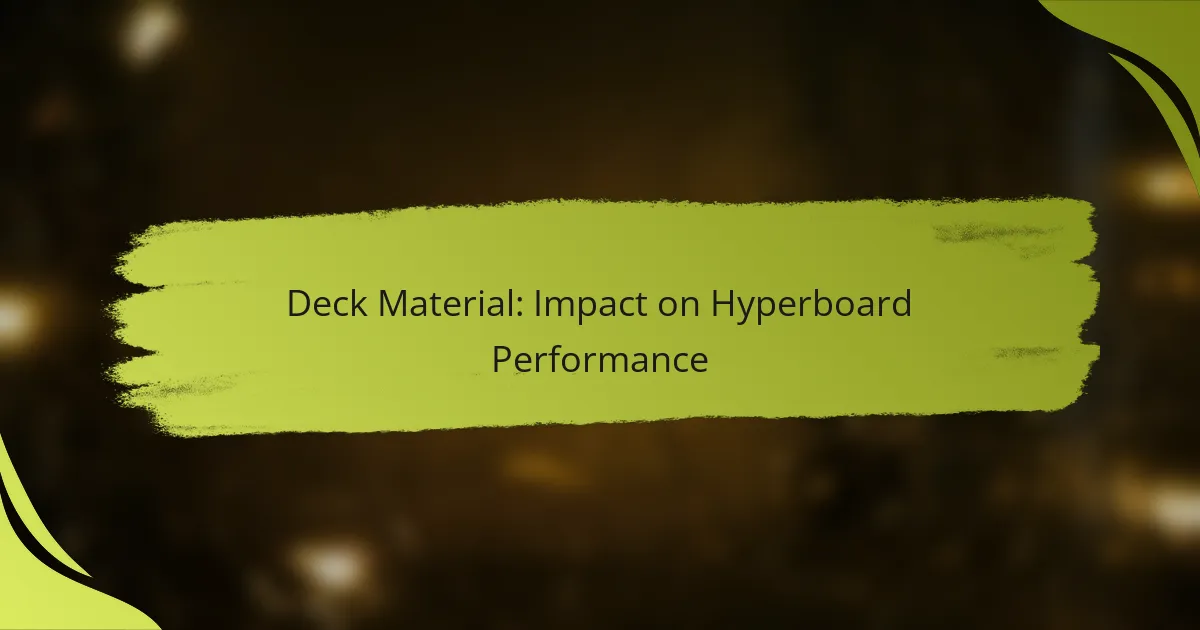The choice of deck material is crucial for optimizing Hyperboard performance, as it directly impacts speed, maneuverability, and durability. Materials such as maple wood, fiberglass, and carbon fiber each provide unique benefits, allowing riders to tailor their boards to specific preferences and riding conditions. Understanding the characteristics of these materials can significantly enhance your overall riding experience.

How does deck material affect Hyperboard performance?
The deck material significantly influences Hyperboard performance by affecting speed, maneuverability, and longevity. Choosing the right material can enhance your riding experience and ensure optimal performance on various terrains.
Material density impacts speed
Material density plays a crucial role in determining the speed of a Hyperboard. Denser materials tend to be heavier, which can slow down acceleration but provide better stability at high speeds. Conversely, lighter materials can enhance speed but may sacrifice stability.
For example, a deck made from lightweight composites may allow for quicker take-offs, while a denser wood deck might offer a smoother ride on rough surfaces. Riders should consider their preferred riding style when selecting deck materials to balance speed and control.
Flexibility influences maneuverability
The flexibility of the deck material directly affects how easily a Hyperboard can be maneuvered. More flexible materials allow for sharper turns and better responsiveness, making them ideal for tricks and agile riding. However, excessive flexibility can lead to a lack of stability at high speeds.
For instance, a moderately flexible deck made from a blend of materials can provide a good balance, allowing for both agility and stability. Riders should evaluate their skill level and intended use when choosing the flexibility of their Hyperboard deck.
Durability affects longevity
Durability is a key factor in the longevity of a Hyperboard, as different materials withstand wear and tear differently. High-quality materials, such as carbon fiber or high-grade plywood, can endure rough conditions and last longer, reducing the need for frequent replacements.
Riders should consider the environments in which they will be riding. For example, if you plan to ride in wet or rugged conditions, investing in a more durable deck material can save money and enhance performance over time. Regular maintenance and care can also extend the lifespan of any deck material.

What are the best deck materials for Hyperboards?
The best deck materials for Hyperboards include maple wood, fiberglass, and carbon fiber, each offering unique benefits that affect performance. Choosing the right material depends on your priorities, such as stability, weight, and agility.
Maple wood for stability
Maple wood is known for its excellent stability, making it a popular choice for Hyperboard decks. Its dense structure provides a solid feel underfoot, which enhances control and balance during rides.
When selecting a maple wood deck, consider the thickness and layering. Thicker decks generally offer more durability, while multiple layers can improve strength without adding excessive weight. Aim for decks that are at least 7-ply for optimal performance.
Fiberglass for lightweight performance
Fiberglass is favored for its lightweight properties, allowing for easier maneuverability and speed on Hyperboards. This material can significantly reduce the overall weight of the board, making it ideal for tricks and quick turns.
When choosing a fiberglass deck, look for options that combine fiberglass with a core material, such as foam or wood, to enhance strength without compromising weight. A deck weighing around 1.5 to 2 kg is typically a good balance for performance.
Carbon fiber for advanced agility
Carbon fiber is the top choice for those seeking advanced agility in their Hyperboard. Its high strength-to-weight ratio allows for quick responses and sharp turns, making it perfect for competitive riding.
While carbon fiber decks can be more expensive, they offer superior performance benefits. Consider investing in a carbon fiber deck if you prioritize agility and are willing to spend in the range of $300 to $600 for a high-quality option. Ensure the deck has a good flex rating to match your riding style.

How to choose the right deck material in the UK?
Choosing the right deck material in the UK involves considering durability, weight, and performance characteristics that align with your riding style and local conditions. Common materials include wood, composite, and plastic, each offering distinct advantages and drawbacks.
Consider local weather conditions
In the UK, weather can be unpredictable, impacting the performance of different deck materials. For instance, wood decks may warp or swell in damp conditions, while composite materials often resist moisture better, providing enhanced durability.
Additionally, if you frequently ride in wet or rainy conditions, opting for a non-slip surface can improve safety. Look for materials that are designed to withstand the UK’s climate, particularly those with water-resistant properties.
Evaluate riding style preferences
Your riding style significantly influences the choice of deck material. For aggressive riding or tricks, a stiffer material like bamboo or a high-quality composite can offer better responsiveness and control. Conversely, if you prefer cruising or casual riding, a more flexible material may provide a comfortable experience.
Consider how often you ride and the types of surfaces you typically encounter. For example, if you ride on rough terrain, a robust material that absorbs shocks will enhance your overall performance. Prioritize materials that align with your specific riding habits for optimal results.

What are the performance metrics of different deck materials?
The performance metrics of various deck materials significantly influence hyperboard performance, including speed, weight capacity, and durability. Understanding these metrics helps in selecting the right material for optimal performance.
Speed comparison of materials
Speed is a crucial performance metric for hyperboards, and different deck materials can affect acceleration and top speed. Generally, lighter materials like carbon fiber can enhance speed due to reduced inertia, while heavier materials may slow down the board’s response time.
For instance, a carbon fiber deck might allow for speeds in the range of 30-40 km/h, while a wooden deck could limit speeds to around 20-30 km/h. Riders should consider the trade-off between speed and stability when choosing their deck material.
Weight capacity of various decks
The weight capacity of a hyperboard deck varies by material and construction. Typically, composite materials can support higher weight limits compared to traditional wood decks, which may have a lower capacity due to their structural limitations.
For example, a well-constructed fiberglass deck might support riders weighing up to 120 kg, while a standard wooden deck may only accommodate around 80 kg. Riders should verify the manufacturer’s specifications to ensure the chosen deck meets their weight requirements.

How do different brands compare in deck materials?
Different brands utilize various deck materials that significantly affect hyperboard performance. Key factors include weight, flexibility, durability, and grip, which can influence ride quality and handling.
Boosted Boards vs. Evolve Skateboards
Boosted Boards typically feature a bamboo and fiberglass composite, providing a balance of strength and flexibility. This material enhances shock absorption, making rides smoother over rough terrain.
Evolve Skateboards, on the other hand, often use a combination of bamboo and carbon fiber. This results in a lighter deck that offers increased stiffness and responsiveness, ideal for aggressive riding styles and higher speeds.
Riptide vs. Landyachtz performance analysis
Riptide boards are known for their use of high-quality maple wood, which offers excellent durability and a solid feel underfoot. This material is favored by riders who prioritize stability and control, especially during high-speed maneuvers.
Landyachtz, in contrast, frequently incorporates a blend of bamboo and maple, which provides a good mix of flexibility and strength. This combination allows for a more playful riding experience, making it suitable for tricks and casual cruising.

What are the long-term benefits of quality deck materials?
Quality deck materials provide significant long-term benefits, including durability, reduced maintenance costs, and improved performance. Investing in high-quality materials can enhance the lifespan of your hyperboard, ultimately leading to better value over time.
Cost-effectiveness over time
Choosing quality deck materials can lead to substantial cost savings in the long run. While the initial investment may be higher, durable materials often require less frequent replacement and maintenance, which can save hundreds to thousands of dollars over the years.
For example, composite decking may cost more upfront than traditional wood, but its resistance to rot and fading means fewer repairs and replacements. This cost-effectiveness is especially relevant in regions with harsh weather conditions, where lower-quality materials may deteriorate quickly.
Enhanced user experience
High-quality deck materials significantly enhance the user experience by providing better performance and comfort. Materials that are designed to withstand wear and tear ensure a smoother ride and improved stability, which is crucial for hyperboard enthusiasts.
Additionally, premium materials often offer better grip and traction, reducing the risk of slips and falls. This is particularly important for users in areas with varying climates, as quality materials can maintain their performance regardless of temperature fluctuations or moisture levels.

What emerging trends are shaping deck materials for Hyperboards?
Emerging trends in deck materials for Hyperboards focus on enhancing performance while prioritizing sustainability. Innovations are leading to lighter, more durable options that cater to both recreational and competitive riders.
Eco-friendly materials gaining popularity
Eco-friendly materials are increasingly being adopted in the production of Hyperboard decks due to growing environmental awareness. Materials such as bamboo, recycled plastics, and bio-resins are becoming common choices, offering a sustainable alternative to traditional wood and synthetic options.
These materials not only reduce environmental impact but also provide unique performance benefits. For instance, bamboo is lightweight and strong, while recycled plastics can offer enhanced durability and resistance to water damage.
When selecting eco-friendly materials, consider their weight-to-strength ratio and how they affect the overall performance of the Hyperboard. Riders should look for certifications or standards that indicate the sustainability of the materials used.
